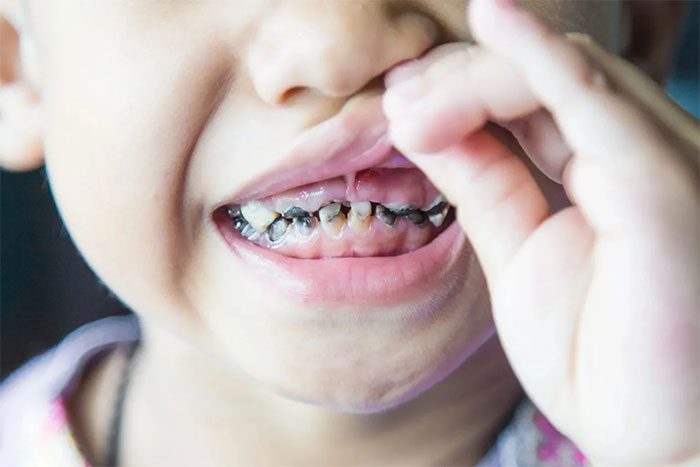Cavities not only affect daily life and the learning spirit of children, but they also lead to aesthetic issues and various other health problems.
Currently, cavities are one of the most common oral health issues across all age groups, especially in children.
According to a survey conducted by the World Health Organization (WHO) in Vietnam in 2019, the prevalence of dental caries in children was 46.5% for primary teeth (ages 1-9) and 28% for permanent teeth (ages over 5).
Causes
According to doctors from the Department of Community Health – Environment – Occupational Diseases at the Ho Chi Minh City Center for Disease Control, a diet high in fats, sugars, and starches combined with poor oral hygiene is one of the primary factors contributing to cavities.

When cavities first begin, failing to seek early treatment can lead to more serious conditions. (Photo: Emmanuelosemotafoundation).
These conditions allow bacteria, acids, and food debris to erode tooth enamel, leading to the formation of cavities. Additionally, using a hard toothbrush with excessive force and improper brushing techniques can wear down teeth and expose the dentin, causing further decay.
When cavities first start, if you do not take proactive measures for early treatment, the situation may worsen. Therefore, when caring for young children, families should pay attention to common signs of cavities such as:
- The appearance of black spots on the surface of the teeth.
- Sharp pain during eating, which may be accompanied by headaches.
- Swollen and bleeding gums, along with bad breath.
Cavities not only affect daily life (eating, sleeping) and learning spirit, but they also lead to aesthetic concerns and other health issues (lymphadenitis, osteomyelitis, cellulitis, sinusitis…).
Prevention
To prevent early cavities in children, parents should limit frequent snacking, especially foods high in fats, sugars, and starches. Encourage children to consume calcium-rich and vitamin-rich foods that are beneficial for teeth, such as yogurt, cheese, apples, carrots, eggs, and fish.
At the same time, children should brush their teeth with fluoride toothpaste at least twice a day, ideally after every meal.
Parents should teach children the correct brushing technique and to apply moderate pressure to avoid damaging the neck and root of the teeth. Additionally, guiding children to use dental floss or water flossers can help clean between their teeth.
Finally, parents need to take their children for regular dental check-ups every six months to help detect and treat oral health issues promptly.


















































